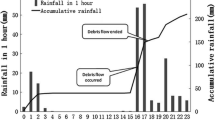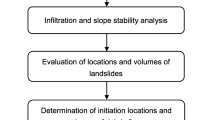Abstract
Many debris flows were triggered in the Chenyulan River Watershed in Taiwan in a rainstorm caused by the Typhoon Toraji. There are 117 gullies with a significant steep topography in the catchment. During this Typhoon, debris flows were initiated in 43 of these gullies, while in 34 gullies, it was not certain whether they have occurred. High-intensity short-duration rainfall was the main triggering factor for these gully type debris flows which are probably entrained by a “fire hose” mechanism. Previous research identified 47 factors related to topography, geology, and hydrology, which may play a role in the formation of gully type debris flows. For a better understanding of the probability of the formation of debris flows, it is proposed to represent the factors related to topography, geology, and hydrology by one single factor. In addition to the existing topographic and geological factor, a normalized critical rainfall factor is suggested with an effective cumulative precipitation and a maximum hourly rainfall intensity. In this paper, a formation model for debris flows is proposed, which combines these topographic, geological, and hydraulic factors. A relationship of these factors with a triggering threshold is proposed. The model produces a good assessment of the probability of occurrence of debris flows in the study area. The model may be used for the prediction of debris flows in other areas because it is mostly based on the initiation mechanisms and not only on the statistical analyses of a unique variety of local factors. The research provides a new and exciting way to study the occurrence of debris flows initiated by a “fire hose” mechanism.





Similar content being viewed by others
References
Akgun A, Dag S, Bulut F (2008) Landslide susceptibility mapping for a landslide-prone area (Findikli, NE of Turkey) by likelihood-frequency ratio and weighted linear combination models. Environ Geol 54:1127–1143
Aleotti P (2004) A warning system for rainfall-induced shallow failures. Eng Geol 73:247–265
Bai HJ (2007) The research of knowledge expression on debris-flow potential analysis by using rough sets theory—a case study of Chen-Yu-Lan stream. Master thesis of Feng Chia University, pp 1–88 (in Chinese with English abstract)
Cannon SH, Gartner JE, Rupert MG, Michael JA, Rea AH, Parrett C (2010) Predicting the probability and volume of postwildfire debris flows in the intermountain western United States. Geol Soc Am Bull 122(1–2):127–144
Catani F, Casagli N, Ermini L, Righini G, Menduni G (2005) Landslide hazard and risk mapping at catchment scale in the Arno River basin. Landslides 2:329–342
Chang TC (2007) Risk degree of debris flow applying neural networks. Nat Hazards 42:209–224
Chang TC, Chao RJ (2006) Application of back-propagation networks in debris flow prediction. Eng Geol 85:270–280
Chang TC, Chien YH (2007) The application of genetic algorithm in debris flows prediction. Environ Geol 53:339–347
Chen X (2007) Evaluation on the occurrence frequency of debris flow in the Chenyulan River watershed. Master thesis of Chang Jung Christian University, pp 1–73 (in Chinese with English abstract)
Chen WF, Li YH, Wu HL (2005) Study of judging debris flow occurrence by combing the physiographical factors and rainfall condition—Chen-Yu-Lan stream watershed as an example. J Taiwan Geogr Inf Sci 2:27–44 (in Chinese with English abstract)
Chen SC, Chen S, Wu CH (2012) Characteristic of the landslides in Shenmu watershed in Nantou County. J Chin Soil Water Conserv 43(3):214–226 (in Chinese with English abstract)
Chou HT, Liaw WM, Yao SW (2002) Threshold conditions for rainfall-induced debris flows. J Chin Civil Hydraul Eng 14(1):1–8 (in Chinese with English abstract)
Coe JA, Glancy PA, Whitney JW (1997) Volumetric analysis and hydrologic characterization of a modern debris flow near Yucca Mountain Nevada. Geomorphology 20:11–28
Fan JH, Yao ZS (1997) A preliminary study on hydrologic and physiographic criteria of debris flow in the east Taiwan Tainan. Conference of agriculture engineering in 1997, Tainan, pp 525–531 (in Chinese)
Fookes PG, Dearman WR, Franklin JA (1971) Some engineering aspects of rock weathering with field examples from Dartmoor and elsewhere. Q J Eng Geol 4(3):161–163
Godt JW, Coe JA (2007) Alpine debris flows triggered by a 28 July 1999 thunderstorm in the central Front Range, Colorado. Geomorphology 84:80–97
Griffiths PG, Webb RH, Melis TS (2004) Frequency and initiation of debris flows in Grand Canyon, Arizona. J Geophys Res 109:F04002 http://dx.doi.org/10.1029/2003JF000077
Huang R, Li W (2009) Fault effect analysis of Geo-Hazard triggered by Wenchuan earthquake. J Eng Geol 18(4):437–444 (in Chinese with English abstract)
Jan CD, Chen CL (2005) Debris flows caused by Typhoon Herb in Taiwan. In: Jakob M, Hungr O (eds) Debris-flow hazards and related phenomena. Springer, Berlin, pp 539–564
Jan CD, Lee MH, Chen JQ (2002) Research on the reliability of discharge of debris flows. Conference of supplement research plan in the management of emergent slope hazards in 2002, pp 251–273 (in Chinese)
Jiang YZ, Lin QY (1991) Analysis on the rainfall characteristics of occurrence of debris flows. J Chin Soil Water Conserv 22(2):21–37 (in Chinese with English abstract)
Johnson AM, Rodine JR (1984) Debris Flow. In: Brunsden D, Prior DB (eds) Slope Instability. John Wiley and Sons Ltd., Chichester, pp 257–361
Kaima TW, Wang WN, Sguzui H (2000) The landslide disaster induced by the Taiwan Chi–Chi earthquake of 21 September 1999. Landslide News 13:8–12
Lan HX, Zhou CH, Wang LJ, Zhang HY, Li RH (2004) Landslide hazard spatial analysis and prediction using GIS in the Xiaojiang watershed, Yunnan, China. Eng Geol 76:109–128
Lee MH (2006) A rainfall-based debris-flow warning analysis and its application. PHD thesis of National Cheng Kung University, pp 1–229
Lee S, Pradhan B (2007) Landslide hazard mapping at Selangor, Malaysia using frequency ratio and logistic regression models. Landslides 4:33–41
Li L (2012) Study on the topographic factor of gully-type debris flows in strong earthquake areas. Master thesis of Chengdu University of Technology, pp 1–82
Lin CY (2009) Effect of topographic factors on the occurrence of debris flow—take the Chen-yu-lan Creek watershed as an example. Thesis of National Chung Hsing University, pp 1–68
Lin JY, Hung JC, Yang MD (2002) Assessing debris-flow hazard in a watershed in Taiwan. Eng Geol 66:295–313
Lin CW, Shieh CL, Yuan BD, Chieh TC, Liu CH, Lee SY (2003) Impact of Chi–Chi earthquake on the occurrence of landslides and debris flows: example from the Chenyulan river watershed, Taiwan. Eng Geol 71:49–61
Liu C, Dong J, Peng Y, Huang H (2009) Effects of strong ground motion on the susceptibility of gully type debris flows. Eng Geol 104(3–4):241–253
Lopez JL, Perez D, Garcia R (2003) Hydrologic and geomorphologic evaluation of the 1999 Debris flow event in Venezuela. In: 3rd international conference on debris-flow hazards, mitigation: mechanics, prediction, and assessment, Davos, Switzerland, Sept. 13–15, 2003
Lu GY, Chiu LS, Wong DW (2007) Vulnerability assessment of rainfall-induced debris flows in Taiwan. Nat Hazards 43:223–244
Ohlmacher GC, Davis JC (2003) Using multiple logistic regression and GIS technology to predict landslide hazard in northeast Kansas, USA. Eng Geol 69:331–343
Protodyakonov MM (1962) Mechanical properties and drillability of rocks. In: Proceedings of the fifth symposium on rock mechanics. University of Minnesota, Minneapolis, pp 103–18
Ranjan KD, Shuichi H, Atsuko N, Minoru Y, Takuro M, Katsuhiro N (2004) GIS-based weights-of-evidence modelling of rainfall-induced landslides in small catchments for landslide susceptibility mapping. Environ Geol 54:311–324
Shieh CL (2001) Primary study on the hazards standard of debris flow during the Typhoon Toraji. In: Symposium of conference on debris flow hazards and mitigation, Chengdu, pp 83–102 (in Chinese)
Shieh CL, Luh YC, Yu PS, Chen LJ (1995) The critical line of debris flow occurrence. J Chin Soil Water Conserv 26(3):167–172 (in Chinese with English abstract)
Shieh CL, Chen YS, Tsai YJ (2009) Variability in rainfall threshold for debris flow after the Chi–Chi earthquake in central Taiwan, China. Int J Sediment Res 24:177–188
Takahashi T (2000) Initiation and flow of various types of debris flow. In: Wieczorek GF, Naeser ND (eds) Debris-flows hazard mitigation: mechanics, prediction, and assessment. Balkema, Rotterdam, pp 15–25
Tan W (1991) Research on the rainfall threshold of debris flow. In: Symposium of second national conference of debris flow, Chengdu, pp 136–142 (in Chinese)
Tan W, Han Q (1992) Research on the critical rainfall of debris flows in Sichuan Province. China. Hazards 7(2):37–42 (in Chinese with English abstract)
Tan W, Wang C, Yao L (1994) Regional prediction of debris flow and landslide on heavy rainfall—in the Panxi Area, Sichuan, China, Chengdu, Sichuan Sciences Press, pp 8–11 (in Chinese)
Tiranti D, Bonetto S, Mandrone G (2008) Quantitative basin characterisation to refine debris-flow triggering criteria and processes: an example from the Italian Western Alps. Landslides 5:45–57
Tunusluoglu MC, Gokceoglu C, Nefeslioglu HA, Sonmez H (2008) Extraction of potential debris source areas by logistic regression technique: a case study from Barla, Besparmak and Kapi mountains (NW Taurids, Turkey). Environ Geol 54:9–22
VanDine DF (1985) Debris flow and debris torrents in the Southern Canadian Cordillera. Can Geotech J 22:44–68
Wang S, Fan X (2006) The Hazards and engineering control of low frequency debris flow. J Mt Sci 24(5):562–568 (in Chinese with English abstract)
Wu J, Kang Z, Tian L, Zhang S (1990) Observation and research on the debris flows in Jiangjia Gully, Yunnan Province, China. Science Press, Beijing, pp 197–221
Yu B, Yang Y, Su Y, Huang W, Wang G (2010) Research on the giant debris flow hazards in Zhouqu County, Gansu Province on August 7, 2010. J Eng Geol 18(4):437–444 (in Chinese with English abstract)
Yu B, Li L, Ma Y, Zhang J, Wu Y, Zhang H, Chu S, Qi X (2011) Research on topographical factors in the formation of gully type debris flows. River, coastal and estuarine morphodynamics: RCEM2011. Tsinghua University Press, Beijing, pp 1–10
Yu B, Chu S, Lu K, Han L, Xie H (2012) A study about the relationship between the frequency of debris flows and lithology. In: Eberhardt et al. (eds) Landslides and engineered slopes: protecting society through improved understanding. Taylor & Francis Group, London, pp 757–761
Acknowledgments
This work was supported by The National Nature Science Foundation of China (NSFC, contract number: 40871054) and The State Key Laboratory of Geohazard Prevention and Geoenvironment Protection Foundation (contract number: SKLGP2010Z004). We especially like to thank Hsien-Ter Chou and Su-Chin Chen for their suggestions and providing information. We thank the reviewers for their comments that helped us to greatly improve the presentation of this work. We are grateful to Dr. Theo van Asch for having provided a very helpful review of the manuscript and for help on the English editing of the manuscript.
Author information
Authors and Affiliations
Corresponding author
Rights and permissions
About this article
Cite this article
Yu, B., Li, L., Wu, Y. et al. A formation model for debris flows in the Chenyulan River Watershed, Taiwan. Nat Hazards 68, 745–762 (2013). https://doi.org/10.1007/s11069-013-0646-6
Received:
Accepted:
Published:
Issue Date:
DOI: https://doi.org/10.1007/s11069-013-0646-6




